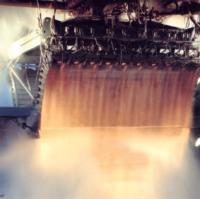 Linear aerospike test firing Linear aerospike test firing | |
| Country of origin | United States |
|---|---|
| Date | 1990's |
| Designer | Rocketdyne |
| Application | X-33 |
| Associated LV | XRS-2200 |
| Status | Development Canceled |
| Liquid-fuel engine | |
| Propellant | LOX / LH2 |
| Configuration | |
| Nozzle ratio | 173:1 |
| Performance | |
| Thrust, vacuum | 2,201 kN (495,000 lbf) |
| Thrust, sea-level | 1,917 kN (431,000 lbf) |
| Thrust-to-weight ratio | 83:1 |
| Chamber pressure | 155 bar (2,250 psi) |
| Specific impulse, vacuum | 455 seconds |
| Specific impulse, sea-level | 347 seconds |
| Dimensions | |
| Measurement | Forward End: 6.4 m (250 in) wide, 2.4 m (94 in) long
Aft End: 2.4 m (94 in) wide, 2.4 m (94 in) long Forward to Aft: 4.3 m (170 in) |
The Rocketdyne RS-2200 was an experimental linear aerospike rocket engine developed by Rocketdyne for Lockheed Martin's VentureStar program. The program was ultimately cancelled in 2001 before any RS-2200 engines were assembled.
XRS-2200
Main article: Rocketdyne XRS-2200The XRS-2200 was a subscale testbed engine that was intended to be developed into the full-scale RS-2200. This engine, unlike its full-scale counterpart, made it to the test stand and accumulated approximately 1,600 seconds of hot-fire testing.
References
- "RS2200 Link". www.hq.nasa.gov. NASA Headquarters. Archived from the original on 2016-03-22. Retrieved 2020-10-03.
- "RS-2200". www.astronautix.com. Encyclopedia Astronautica. Archived from the original on 2020-02-18. Retrieved 2020-10-03.
- ^ "Are Aerospike Engines Better Than Traditional Rocket Engines?". Everyday Astronaut. 2019-10-18. Archived from the original on 2020-09-24. Retrieved 2020-10-02.
- "XRS-2200/RS-2200 Linear Aerospike Engine Data Sheets". heroicrelics.org. Archived from the original on 2019-09-12. Retrieved 2020-10-02.
- "RS-2200 Linear Aerospike Engine". 1999-11-28. Archived from the original on 1999-11-28. Retrieved 2020-10-02.
![]() This article incorporates public domain material from websites or documents of the National Aeronautics and Space Administration.
This article incorporates public domain material from websites or documents of the National Aeronautics and Space Administration.